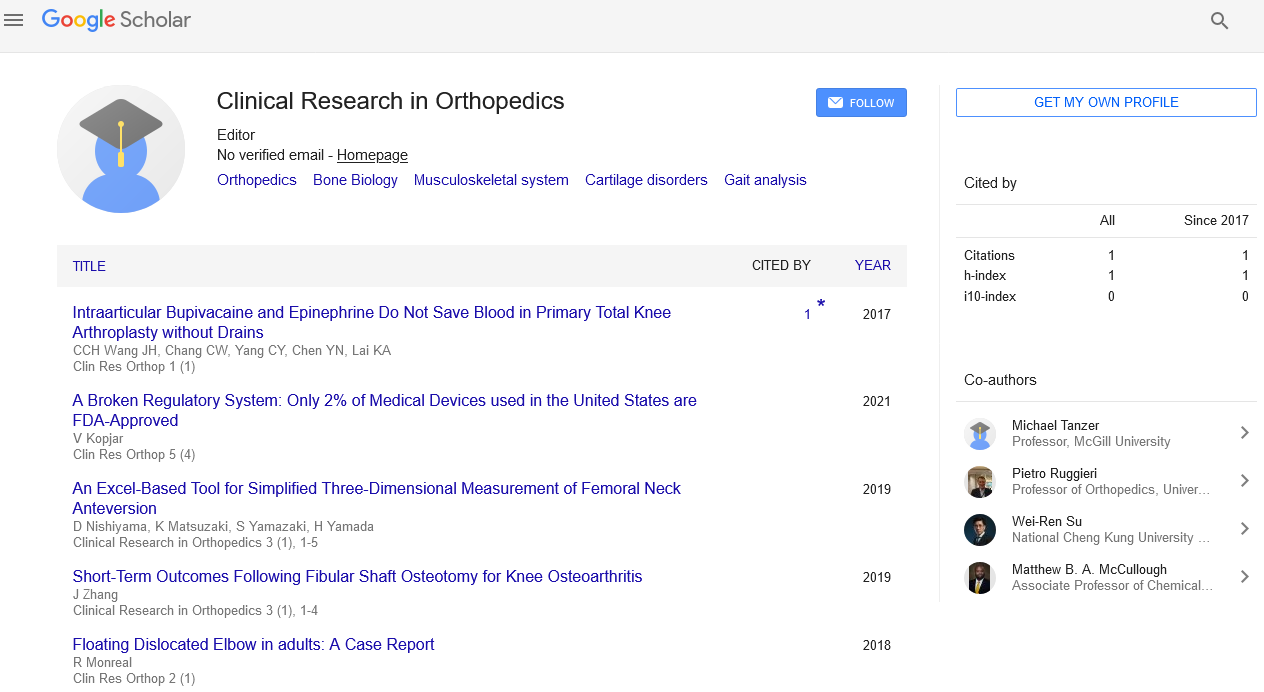Twelve to 16 year clinical and radiological outcomes of periacetabular osteotomy and its effect on total hip arthroplasty component position
Ahmed A Awaji and John Rudan
Queens University, Kingston, Saudi Arabia
Queens University, Kingston, Canada
: Clin Res Orthop
Abstract
Purpose: We assessed the long-term results of periacetabular osteotomy (PAO) to determine the clinical and radiological outcomes for patients who developed osteoarthritis secondary to hip dysplasia. We separately evaluated the effect of PAO in patients who later underwent conversion to total hip arthroplasty (THA). Methods: Forty patients were treated with PAO by a single surgeon in the same center from 1999 to 2006. Nine patients (10 hips) were lost to follow-up. The remaining 31 patients (37 hips) were retrospectively reviewed at an average follow-up time of 14 years. Hips were evaluated by using the modified Harris hip score and the Tonnis radiological classification. The central edge angle was also recorded before and after PAO, as well as prior to THA. In cases where patients were converted to THA, the inclination and anteversion measures were recorded. Results: The mean age of the PAO patients was 36.9 years (range 16–49). The average surgical time for PAO was 4 hours 37 minutes (SD 42 mins), and the average estimated blood loss during surgery was 557 mL (SD 186). The ASA score median was 1. The mean Harris hip score at followup was 83 (SD 24) and ranged from 26 to 113. The median Tonnis classification of osteoarthritis based on radiographic changes was 2. The center edge angle improved significantly, from a mean of 15.6 (SD 10.5) preoperatively to a mean of 32.8 (SD 3.3) at follow-up. Eighteen of the 37 hips were converted to THA. The mean central edge angle prior to THA was 12.7 (SD 9.2). The mean inclination in these cases was 44.9 (SD 6.8), and the mean anteversion was 17.5 (SD 5.2). Nine patients experienced complications. Eight of these patients developed moderate to severe pain secondary to greater trochanteric bursitis. One patient from the bursitis group developed non-union pelvic osteotomy, and another developed hip impingement secondary to prominent PAO hardware (screws). Two patients in the converted THA group had a revision. One had a septic loosening of the acetabular and femoral components, and the other experienced femoral periprosthetic fracture secondary to excessive femoral anteversion. Conclusion: Periacetabular osteotomy is a useful and predictable procedure in young patients with symptomatic hip dysplasia. The procedure can improve pain relief and femoral head coverage and slow the progression to THA conversion. Furthermore, the PAO procedure did not affect the THA component position in our patient population, but there were variable results with regard to functional activity and pain levels compared to older aged patients who undergo total hip Arthroplasty.
Biography
Ahmed A Awaji, he is a consultant orthopedic surgeon in King Salman Armed Forces Hospital, Saudi Arabia. He published many research articles on Hip, Knee Arthroplasty and Lower extremity Reconstruction in the field of orthopedics. He received several awards and rewards in the course period of 2008- 2017. His field of interest includes Hip, Knee Arthroplasty and Lower extremity Reconstruction.
E-mail: aaawaji@hotmail.com
 Spanish
Spanish  Chinese
Chinese  Russian
Russian  German
German  French
French  Japanese
Japanese  Portuguese
Portuguese  Hindi
Hindi 